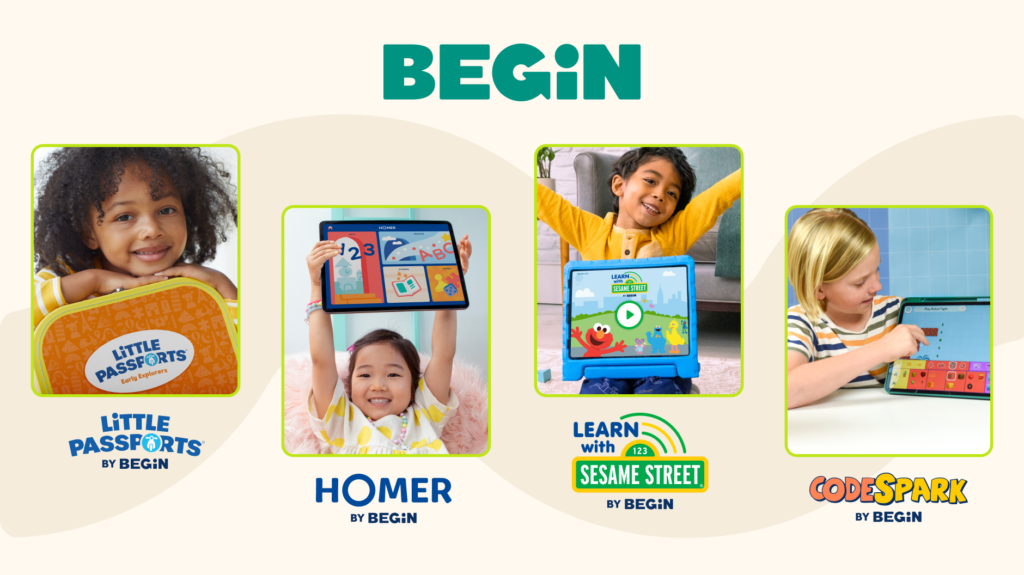Does it sometimes feel like your child isn’t the greatest at following directions? Or the older they get, the more they want to do everything their way, regardless of the instructions given to them?
Following directions may seem like a personality trait, but it’s actually a part of developing Critical Thinking, one of the 5 C’s at the heart of the Begin Approach to helping kids thrive in school and life. Critical Thinking is one of the most sought-after skills among employers. It also helps kids make good decisions and tell the difference between trustworthy and untrustworthy information.
The Short Cut
- Following directions is part of developing Critical Thinking, one of the 5 C’s that help kids thrive in school and life
- Kids get better at following directions as their brains develop—most kids become able to follow three- and four-step instructions in kindergarten
- Parents can help by making directions clear, focused, and age-appropriate; giving kids time to process them; staying calm; and offering positive reinforcement for success
- Developing the 5 C’s doesn’t need to be complicated. You can make a big difference in only 15 minutes a day!
It’s important to know that if your kids struggle to follow instructions, you’re not alone. The truth is sometimes following directions is difficult for kids, and it doesn’t mean there’s anything wrong with them! It’s a skill they have to learn like any other.
In this article, we’ve compiled a list of effective strategies you can try at home to help them follow directions. Let’s get started!
Why Is Following Directions Important?
The ability to follow directions is a basic life skill that will serve your child well both now and in the future.
When you look at the various aspects of our everyday lives and daily interactions with others (like following the user manual’s instructions for a new gadget), you realize how much this skill actually allows us to accomplish.
For kids, in particular, there are a couple of key benefits to following directions.
Children Can Function In Different Environments
As much as we’d like to keep them all to ourselves, our children aren’t going to stay at home for the rest of their lives.
They are going to go to school, take tests, participate in sports, go to camps, visit a friend’s house, etc. Learning to follow directions will help them function effectively across these different environments.
It Keeps Kids Safe
No matter where kids are—at home, school, a playground, or a friend’s house—following rules is important for safety, too. It’s never too early to teach basics like not wandering off in public places and holding an adult’s hand when crossing a street. It can make a huge difference during stressful situations and emergencies.
On top of that, helping your child learn how to follow directions can:
- Maintain order at home
- Impact their ability to complete tasks and reach the desired purpose
- Learn new skills
- Keep them calm and feeling secure as they know what comes next
The Age Factor

Before discussing the different strategies you can try at home, it’s important to mention the role age plays in our children’s ability to follow directions.
0 – 24 Months
Trying to get a newborn to follow directions is unrealistic. However, as you respond to their cues (like hungry and tired cries) and they respond to yours, it helps lay a solid foundation for cooperative interactions.
As children enter the toddler stage, they are usually able to begin following simple, one-step instructions, such as “Wave bye-bye to Laura!” or “Give mommy the book.” Keep in mind that attention spans at this age are super short, so be clear and make eye contact with your child.
Children seek lots of adult approval at this stage, and making your tone of voice enthusiastic and appreciative can help influence how your toddler responds.
Giving positive feedback is also a great way to encourage kids. So, if they don’t do as you say, rather than responding negatively, focus on what they should be doing instead.
2 – 4 Years
At the preschool level, most children can understand and follow two-step instructions. For example, “Put your toys in the box, then place the box in the corner.”
If your child hasn’t yet developed this ability, don’t worry. At this stage, kids are still learning the valuable skill of listening and paying attention to the details in the information given.
To help your child process information and instructions, you can continue to give them lots of positive reinforcement.
In addition, remember to also give them simple choices. For example, “Get your green shirt out of the bottom drawer” is more challenging than pointing to a visible shirt and asking them to get it.
4 – 6 Years
At this stage, your child’s vocabulary and listening skills have improved. This can make following directions a bit easier.
Most kindergarteners can follow three- or four-step instructions. They may also ask questions to seek clarification.
To help your child continue to improve this skill, you can:
- Break complicated directions into smaller steps
- Give instructions in context (for example, if your child is learning to draw, give instructions while they are busy with the activity)
- Keep a fun and playful tone while giving directions to help motivate them
Following directions is a skill that your child will use for the rest of their life. So, here are seven strategies to help them improve.
Tips to Encourage Following Directions
1. Get Your Child’s Attention

Before giving your child directions, it’s essential that you have their full attention. Otherwise, the activity will feel impossible for both you and them.
You can gain their attention by simply asking for it—e.g., “Look toward me now. I need to tell you something.” Getting down to your child’s level can also help.
2. Be Clear
One of the key components for helping your child learn to follow directions is being clear on what you need them to do. To achieve this, be direct and use simple language.
For instance, “It’s time to jump into bed,” is much better than, “You need to sleep early. We have a long day ahead tomorrow, and it would be great for you to get enough rest.”
You might assume that the latter will help a child become more understanding. However, giving too many details may lead to a child getting “lost” in the information you’re giving them. It’s best to say what’s necessary and leave the rest out.
3. Focus on One Instruction at a Time
Going along with the previous point, we sometimes make the mistake of giving children too many instructions at one time.
For example, we might say, “Pick up your toys, place them in the toy box, wash your hands, and then tell your brother it’s time to eat.”
With this many instructions, it can be hard for your child to prioritize or decipher what they’re actually supposed to do. That’s why, whenever possible, it’s best to give one instruction at a time or group them together in a way that makes sense.
Using the example above, you could hand your child a toy and ask them to put it in the toy box. Then hand them another one and do the same. When this is easy for your child, you can then group instructions together by saying, “Pick up your stuffed lion and put it in the toy box.”
Then you may want to move on to even more complicated directions. For example, you may have them pick up all the toys on the floor and put them in the toy box. Finally, once they’ve completed that, ask them to wash their hands and tell their brother that it’s time to eat.
4. Number Your Instructions
This tip is very effective if you’re going to be grouping your instructions into manageable tasks. Simply number the directions you’re giving your child.
For example, start with, “I need you to do three things right now,” or “Pay attention. There are four things I need you to do.” You can also use ordinal numbers such as “first,” “second,” “third,” and so forth to label each task.
By using this technique and verbiage, you can help your child become aware that there is more than one thing being asked, and they can distinguish between and keep track of to-dos on their list.
While numbering your instructions helps make things clear, it’s still important to keep the list relatively short. Because people can typically only hold up to four different things in their working memory, we recommend giving no more than four instructions at a time.
5. Help Your Child Visualize the Instructions
Giving visual cues can be very effective in helping your child understand what you need them to do. To use this tactic, demonstrate a task and then ask them to follow your example.
For example, “Watch me carefully. See how I’m arranging this plate, fork, and spoon? I need you to set the rest of the table just like this.”
This “me first, now you” approach allows your child to visualize exactly what you want them to do before giving it a go. It can also be a very effective strategy to use with children who have language processing challenges.
6. Allow Your Child to Process the Information

You know how you sometimes have to pause and think through information you’ve just read or heard? Kids need that, too, especially when they’re learning to follow directions.
After giving them instructions, allow a few seconds to pass, which may help the information sink in.
Doing this may also help your child learn to listen the first time, rather than requiring you to repeat yourself. However, if they don’t do as you say or seem confused, it’s OK to repeat the instructions.
7. Minimize Distractions
Children have short attention spans. That’s why it’s essential to keep their attention when you have it.
If the TV is on in the background or they’re busy playing games, it’s going to be challenging for them to follow through on any of your instructions. Turn the TV off. Have them put their game or anything else they’re busy with down and give you their full attention.
Another essential component is to give your child your full attention as well. This may help them realize that the information is important.
8. Focus on Tone of Voice

You know the phrase, “It’s not what you say, it’s how you say it”? Different people can recite the same words, but the differences in tone, volume, pace, and pitch can completely change the message.
When it comes to helping children follow directions, it’s much more effective to speak in a calm, clear, and even tone. Remember that you want your child to focus only on the instructions and not the volume or tone.
9. Don’t Ask, Tell
Sometimes children are in the mood for a power struggle and phrasing the directions in a way that it seems like there’s room for negotiation will not help you.
If you give directions such as, “Would you pick up your toys, please?” It may give your child the impression that they don’t have to do it.
Instead, change the wording to, “It’s time to pick up your toys,” as this makes it clear that they don’t have a choice.
10. Offer Praise

Positive reinforcement is a great way to help your child feel good about following your instructions. So, clap your hands, cheer them on, give them a high five, or pat them on the back to show that you’re happy about what they’ve just done.
The more they realize how happy you are, the better they’ll feel about listening to your instructions, and the easier it will be for them to continue following your directions in the future.
Activities to Help with Following Directions
Plenty of games and activities can help you encourage your child to get into the habit of following directions. These include:
- Follow The Leader
- Simon Says
- I Spy
One of our favorite activities to help develop this skill is what we call the “playful instructions game.” This is where you give children instructions by adding playful elements.
For example, ask your child to jump as high as possible and then make a silly face. For older kids, you can even add more playful instructions (stick your tongue out, wiggle your nose, etc.).
This game can be incorporated into your regular routines — jump out of bed, tiptoe to the bathroom, and grab a toothbrush. Adding a playful element can make mundane routines much more fun.
In addition to the well-known games above, we’ve included a few more activities to help your child learn to follow instructions.
Red Light, Green Light

To prepare for this game, clearly define the playing area and mark the start and finish lines with a strip of tape on the floor (or ground if you’re outside). Safety comes first, so feel free to push things out of the way if you need a little more room to move around.
To begin, have all players stand on the starting line. Then, when you say “Green Light,” everyone moves toward the finish line. But, as soon as you say “Red Light,” everyone needs to immediately stop.
Anyone who is caught moving when “Red Light” is called out has to go back to the starting line. The first person to make it across the finish line wins the game!
This listening and moving game uses simple instructions to encourage children to follow directions—and have some fun while doing so!
Grid Game
The goal of this activity is simple: Make your way through a grid by following instructions.
Start by creating a numbered grid on your floor. The size of the grid you create will depend on the space you have available. But whether you create a 4×4, 5×5, or 6×6 grid, make sure all the squares are the same size.
(You can either use your feet—one foot in front of the other—to measure each square, or you can use an actual ruler. It’s totally up to you.)
The type of floor you have will also dictate the type of tape you can use to create your grid, but masking tape usually works well for most floors because it easily comes off without causing damage.
To play this game, have your child stand in the first square and then follow your instructions to move throughout the grid.
Your instructions could look something like this:
- Take two steps forward.
- Take one step backward.
- Take two steps to your right.
- Take three steps to the left.
As they move this way and that within the defined space, it’s great practice because they have to switch gears quickly and listen carefully to the directions you’re giving.
Visual Directions
For this activity, simply make cards using your child’s routine. For example, let’s say your child’s bedtime routine is the following:
- Take a bath
- Put on pajamas
- Brush teeth
- Get into bed
- Read a book
- Sleep
Print out images of a bathtub, a toothbrush, pajamas, a bed, a book, and a child sleeping to represent each part of the routine.
Next, stick each of these pictures on a numbered index card. Then, whenever it’s time for bed, your child can just grab their card stack and follow the instructions.
This can work for any routine, so feel free to adapt it as necessary. It’s also a helpful tactic if you have a nonverbal child.
Using cards as a method of explaining instructions can eliminate unnecessary confusion, promote confidence in daily activities, and increase cooperation between a parent and a child.
Things to Consider When Giving Directions
Avoid Empty Threats

Sometimes parenting little humans can get overwhelming, especially when they are in a defiant mood.
This may lead to making impulsive threats, like, “If you don’t set the table right now, you’re going to be sorry!” Or, “I’m giving you two minutes to clean up. If this isn’t done by the time I get back, you’re going to be in big trouble!”
The problem with making such statements is that they tend to shut down communication and lead to power struggles. While threats may give you short-term gains (i.e., your child performing the tasks you want them to), they’re not ideal for the long haul.
It’s important to teach children to communicate their needs and wants clearly and, if there is a disagreement, how to get their point across calmly and respectfully.
So, remember to stay calm when addressing your child. If you notice that they are being extra defiant and their behavior is making you lose your patience, consider taking a moment to calm down before conversing with them.
Sometimes Reasoning Doesn’t Help
As adults, we often want to understand why things need to be done because this can help motivate us to perform a specific action. But explanations don’t always work for children, especially those under six years of age.
For example, “If you don’t pick up your toys after using them, you might end up stepping on them and hurting yourself. I want you to tidy up because it’s best to have a clean space so you can move around freely.”
While such a statement might work for older kids, younger children aren’t able to relate to future consequences, so they may not get motivated to perform a task. This is another reason it’s best to keep directions short and to the point.
Empower, Don’t Overpower

We’ve discussed how important it is to give clear instructions, and in some instances, this means not asking your child but telling them what to do. This approach works perfectly for young children who cannot grasp explanations and extra information from your directions.
But as children get older, they may start to respond to different situations independently.
For example, if you’ve always told them to pick up their toys because they may hurt themselves, they may decide that leaving toys lying around on one side of the room, where they are out of the way, works better than actually having to tidy up.
Sometimes parents view this as disrespectful behavior and resort to overpowering their children. Unfortunately, this can make children feel powerless and encourage defiance as they fight to “take back their power.”
A great solution may be to allow children some freedom to make their own decisions from time to time, as they get older. For example, if they complain about their bedtime routine, encourage them to find what may be a better solution.
This is not to say that children should do as they please. You’re still the parent! However, as children get older and start thinking independently, it’s perfectly fine to allow them room to make some decisions (at your discretion, of course).
Learning to Follow Directions with Begin

It can be challenging to get children to follow instructions, and that’s OK! It’s all part of growing up, and they’ll get better at it with time and practice. We hope our suggestions help. Sometimes simplicity, clarity, and a little fun are all you need.
And if you need more help, check out our age- and stage-matched learning membership! It gives kids access to age-appropriate hands-on and digital learning games and activities that offer great practice at following directions.
Take our online quiz to find out how we can help your family today!












